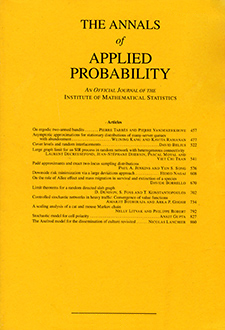Abstract
We consider the minimax quickest detection problem of an unobservable time of proportional change in the intensity of a doubly-stochastic Poisson process. We seek a stopping rule that minimizes the robust Lorden criterion, formulated in terms of the number of events until detection, both for the worst-case delay and the false alarm constraint. This problem, introduced by Page [Biometrika 41 (1954) 100–115], has received more attention in the continuous path framework (for Wiener processes) than for point processes, where optimality results only concern the Bayesian framework [In Advances in Finance and Stochastics (2002) 295–312, Springer, Berlin]. We prove the CUSUM optimality conjectured but not solved for the Poisson case of the CUSUM strategy in the general setting of the stochastic intensity framework. We use finite variation calculus and elementary martingale properties to characterize the performance functions of the CUSUM stopping rule in terms of scale functions. These are solutions of some delayed differential equations that can be solved simply. The case of detecting a decline in intensity is easier to study, because the performance functions are continuous. In the case of a rise where the performance functions are not continuous, differential calculus requires using a discontinuous local time at the discontinuity level, difficult to estimate. The conjecture was considered proven by the community, but the proof was still lacking for this reason. Some numerical considerations are provided at the end of the article.
Citation
Nicole El Karoui. Stéphane Loisel. Yahia Salhi. "Minimax optimality in robust detection of a disorder time in doubly-stochastic Poisson processes." Ann. Appl. Probab. 27 (4) 2515 - 2538, August 2017. https://doi.org/10.1214/16-AAP1266
Information





